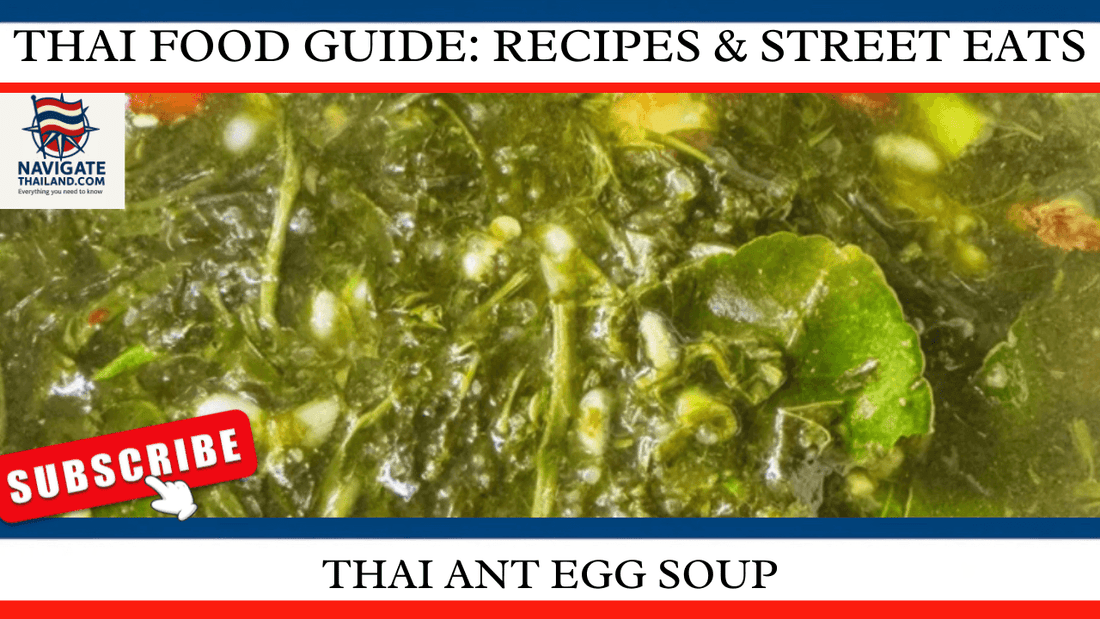
Thai Ant Egg Soup: Tom Kai Mot Daeng
Share

Thailand’s Isaan region is home to a variety of unique and tantalising culinary experiences, but few dishes stir curiosity like Tom Kai Mot Daeng—the famous Isaan ant egg soup. For the adventurous traveller or curious foodie, this dish offers a fascinating blend of tradition, culture, and flavour that reflects the ingenuity of the local people. This article delves deep into everything you need to know about Isaan ant egg soup, from the ants themselves to the time-honoured methods used to collect these prized eggs. By the end of this read, you’ll not only understand why this dish is so special, but you might also be tempted to try it yourself!
The Ants Behind the Soup: Who Are They?
The key ingredient in Tom Kai Mot Daeng is the red ant, scientifically known as Oecophylla smaragdina, or commonly referred to as weaver ants. These ants are well-known in Southeast Asia, and their eggs, larvae, and pupae are considered delicacies in Isaan cuisine. These tiny creatures live high up in the canopies of trees, where they construct nests by weaving leaves together using their silk—a fascinating feat of nature.
The eggs and larvae are usually collected during the dry season, between February and April, when they are most abundant. This makes ant egg soup a seasonal delicacy in Thailand, often found at local markets during these months. The eggs themselves resemble tiny, white grains of rice but are softer and more delicate. They are often described as having a slightly tangy taste with a mild texture, and they are highly sought after by locals and food enthusiasts alike.
How Are Ant Eggs Collected?
Collecting ant eggs is no easy feat and requires skill and bravery, as the ants will fiercely protect their nests. Traditionally, locals use long bamboo poles with a small net attached to the end to reach high into the trees and gently scoop out the eggs. This practice is passed down through generations, and many families take part in the seasonal harvest.
Once the eggs are collected, they are carefully cleaned to remove any debris or ants that may have clung on during the process. What’s fascinating about this tradition is that every part of the ant nest is utilised. The larger adult ants are often eaten as snacks or used to flavour dishes, while the delicate eggs are reserved for soups and salads.
The Flavours of Tom Kai Mot Daeng
So what does Isaan ant egg soup actually taste like? The flavour of the soup is a harmonious combination of spicy, sour, and savoury notes—quintessential characteristics of Isaan cuisine. The soup base is typically made with ingredients like lemongrass, kaffir lime leaves, galangal, and chillies, which give the dish its vibrant, aromatic qualities.
The star of the dish, however, is the ant eggs themselves. Their slightly sour flavour complements the strong herbs and spices, while their soft, almost creamy texture contrasts with the crunchy vegetables and herbs often added to the soup. Some variations of the dish include adding frog meat or fish, making it even more of a protein-rich feast.
For the uninitiated, the idea of eating ant eggs might seem daunting, but those who have tried it often describe the experience as deliciously unique, with the eggs adding a layer of depth to the broth that’s unlike anything else. Plus, if you’re a fan of dishes like Tom Yum or Tom Kha, you’ll likely find the flavour profile of ant egg soup both familiar and exciting.
Cultural Significance and Tradition
Tom Kai Mot Daeng isn’t just a culinary curiosity; it’s deeply rooted in the culture and traditions of the Isaan people. The dish is closely tied to rural life and reflects the resourcefulness of communities who make the most of the natural ingredients available to them. For centuries, the Isaan people have been using ingredients like ants and their eggs, not only as a food source but also as a way of connecting with their environment.
The act of harvesting ant eggs is often a communal activity, bringing families and neighbours together to partake in the collection. This seasonal event has become a celebration of sorts, with local markets bustling with ant egg sellers during the harvest season. Eating the dish itself is also a shared experience, often enjoyed with family and friends during special gatherings.
Nutritional Value of Ant Eggs
Beyond the cultural and culinary aspects, ant eggs are also incredibly nutritious. They are rich in protein, which makes them an excellent food source for those living in rural areas with limited access to other forms of protein. In fact, ant eggs contain about 8.2 grams of protein per 100 grams, which is higher than some types of meat. They are also a good source of calcium, magnesium, and essential fatty acids, all of which are vital to a healthy diet.
Interestingly, the adult ants used in some dishes are high in formic acid, giving them a natural sour taste that complements the tangy soup. This combination of high protein and acidity makes ant egg soup not only flavourful but also packed with nutrients that promote good health.
Fun Fact: A Sustainable Food Source
In recent years, insects, including ants, have gained recognition as a sustainable and eco-friendly food source. Ants, unlike traditional livestock, require very little space and resources to farm, making them an environmentally friendly option for communities looking to reduce their carbon footprint. As global interest in edible insects grows, Isaan’s ant egg soup could very well become a symbol of sustainable eating practices.
Where to Try Ant Egg Soup
If you’re visiting Thailand, especially during the ant egg harvest season, you’ll have the best chance of tasting this unique dish in local markets and restaurants throughout the Isaan region. Cities like Khon Kaen, Udon Thani, and Nakhon Ratchasima are popular destinations where you can find Tom Kai Mot Daeng served fresh.
For the more adventurous traveller, seeking out a homestay experience in a rural village can offer a more authentic way to try the dish. Many villages offer cooking classes or food tours that allow you to participate in the process of collecting and preparing ant eggs.
Conclusion: Embrace the Adventure
Tom Kai Mot Daeng is more than just an exotic dish—it’s a reflection of the deep connection between the Isaan people and their environment. From the intricate process of collecting the eggs to the vibrant flavours of the soup, this dish is an adventure for the senses and an opportunity to experience a unique aspect of Thai culture.
So, if you’re ever in Isaan during ant egg season, don’t miss the chance to try Tom Kai Mot Daeng. It might just be the culinary highlight of your trip!
We’d love to hear your thoughts! Have you ever tried ant egg soup, or would you be willing to give it a go? Let us know in the comments below, and don’t forget to share this blog with your friends on social media. Also, stay tuned for more fascinating stories about Thailand’s rich culture and cuisine by subscribing to our YouTube channel. We’ll be turning these blog posts into videos, so make sure to like, subscribe, and hit the notification bell to never miss an update!
The Thai name for ant egg soup is ต้มไข่มดแดง (Tom Kai Mot Daeng).
Phonetic Thai Spelling:
Tom Kai Mot Daeng
• Tom = ต้ม (boiled or soup)
• Kai = ไข่ (egg)
• Mot Daeng = มดแดง (red ant)
Thai Script Spelling:
ต้มไข่มดแดง
This is how the dish is commonly written and pronounced in Thailand.
Read more of our Thailand blog series:
Thai Food Guide:Traditional Recipes and Street Eats
Everything Travellers Need to know
Thailand travel ebooks and language guides
Thailand Travel Apparel & Souvenir Gifts
Subscribe to our YouTube channel Navigate Thailand to see our most popular Thailand travel blogs turned into videos:
Navigate Thailand YouTube channel











































































































































